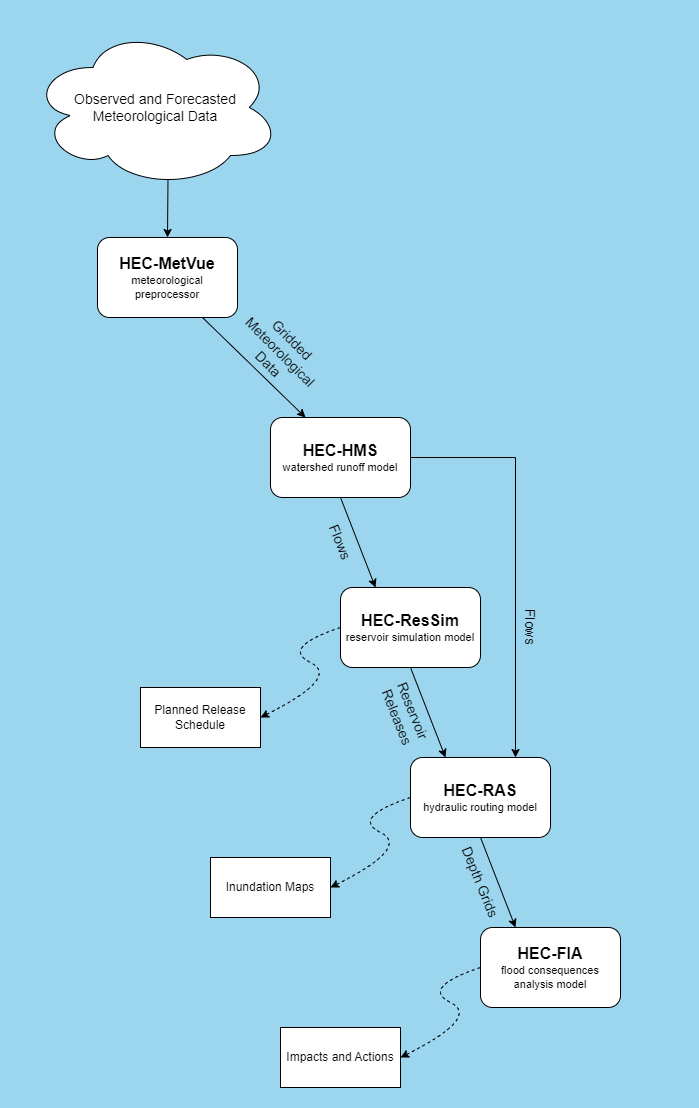Download PDF
Download page Running Forecast Models.
Running Forecast Models
Once you are satisfied with your time-series data, you are ready to create a CWMS forecast. A CWMS forecast is a simulation of watershed processes and consequences of potential flooding using various applications configured in CWMS. The hydrologic application, HEC-HMS, computes flow from forecasted and observed meteorological time series. The reservoir operation application, HEC-ResSim, computes reservoir releases and downstream flows. The hydraulic application, HEC-RAS, computes river stages and outputs inundation maps. The impact analysis application, HEC-FIA, computes flood consequences and produces action reports.
Prior to creating a CWMS forecast, you will have to create Model Alternatives, assign Model Alternative Keys, define the Program Order, define Forecast Runs, and configure the Model Linking.
For your routine CWMS forecasting, you might create a CWMS forecast using a forecast run that includes something similar to the following model alternatives: normal conditions (for HEC-HMS), normal reservoir operations (for HEC-ResSim), normal river conditions (for HEC-RAS), and no flooding consequences (for HEC-FIA).
If a high rainfall event is forecasted, you might create a CWMS forecast using a forecast run with model alternatives similar to the following: wet basin conditions (for HEC-HMS), restricted downstream channel capacity (for HEC-ResSim), high channel flow (for HEC-RAS), and evacuate with warning (for HEC-FIA).
In the Modeling module, you specify a forecast time window, create and manage forecast extract and post lists, extract time-series data for the forecast, create and manage forecast alternatives, edit selected model parameters, and run the models. The figure below shows the data flow concepts through the five standard CWMS analysis applications (HEC-MetVue, HEC-HMS, HEC-ResSim, HEC-RAS, and HEC-FIA).

Meteorological Preprocessor (HEC-MetVue)
HEC-MetVue combines observed and forecasted hydrometeorological data into a single dataset that can be used by the watershed runoff model, HEC-HMS.
Hydrologic Modeling (HEC-HMS)
HEC-HMS computes runoff using the observed and future precipitation data, including uncontrolled local flows that are typically used by HEC-ResSim. The parameters you might adjust to calibrate the model are loss rates and baseflow.
Reservoir Simulation (HEC-ResSim)
After the upstream boundary flows and uncontrolled local flows have been computed by HEC-HMS, you will run the reservoir simulation application HEC-ResSim to operate the reservoirs and compute regulated flows. Reservoir operations might include zones and rules for day-to-day operations, along with zones and rules for extreme events. As long as the reservoir starting conditions are linked to real-time data sets (starting elevations or storages, reservoir or outlet releases, and any other boundary conditions needed by your model), then you should not have to make any revisions to your HEC-ResSim model in order to run your routine CWMS forecasts.
River Analysis (HEC-RAS)
Regulated flows computed by HEC-ResSim are typically used as boundary conditions to the hydraulic routing model, HEC-RAS. Computed flows from HEC-HMS or supplemental models should also be used as input to HEC-RAS. In turn, HEC-RAS computes water surface elevations, which is the input to HEC-FIA. The parameters you might adjust to calibrate the model are Manning's n values at selected cross sections.
Flood Impact Analysis (HEC-FIA)
HEC-FIA analyzes impacts within inundated areas based on computed hydrographs from HEC-ResSim and elevations from HEC-RAS. HEC-FIA calculates flood damage determined by rising stage in a stream, river, lake, or reservoir. HEC-FIA also computes action reports that tell responders what they need to do based on the computed stage values. The parameters you might adjust for your forecast are levee failure stages to see the associated damage and impacts during an event.